Environmental Impact Assessment: Hemsby Wind Farm EIS Review Report
VerifiedAdded on 2023/01/11
|16
|5166
|82
Report
AI Summary
This report provides a comprehensive review of the Environmental Impact Statement (EIS) for the Hemsby Wind Farm project, focusing on the assessment of environmental impacts. The report begins with an introduction that outlines the purpose and background of the EIS, followed by a detailed description of the methodology used, which is based on an adapted version of the Oxford Brookes University Environmental Impact Statement Review Package. The findings reveal that the EIS received a D grade due to several shortcomings, including the lack of public participation, insufficient consideration of health impacts, and inadequate mitigation measures. The report assesses the range and characteristics of environmental impacts, the appropriateness of the methods and techniques used to gather and present environmental information, and the approaches used to describe the ES and identify uncertainties. The study also examines the criteria used to make judgments about environmental impact significance and mitigation methods, along with the treatment of social or human health impacts and the effectiveness of public participation methods. The conclusion summarizes the key deficiencies that led to the low grade, highlighting the need for improved mitigation strategies and a more comprehensive approach to environmental impact assessment. The report is a student contribution for Desklib, a platform that provides students with AI-powered study tools.
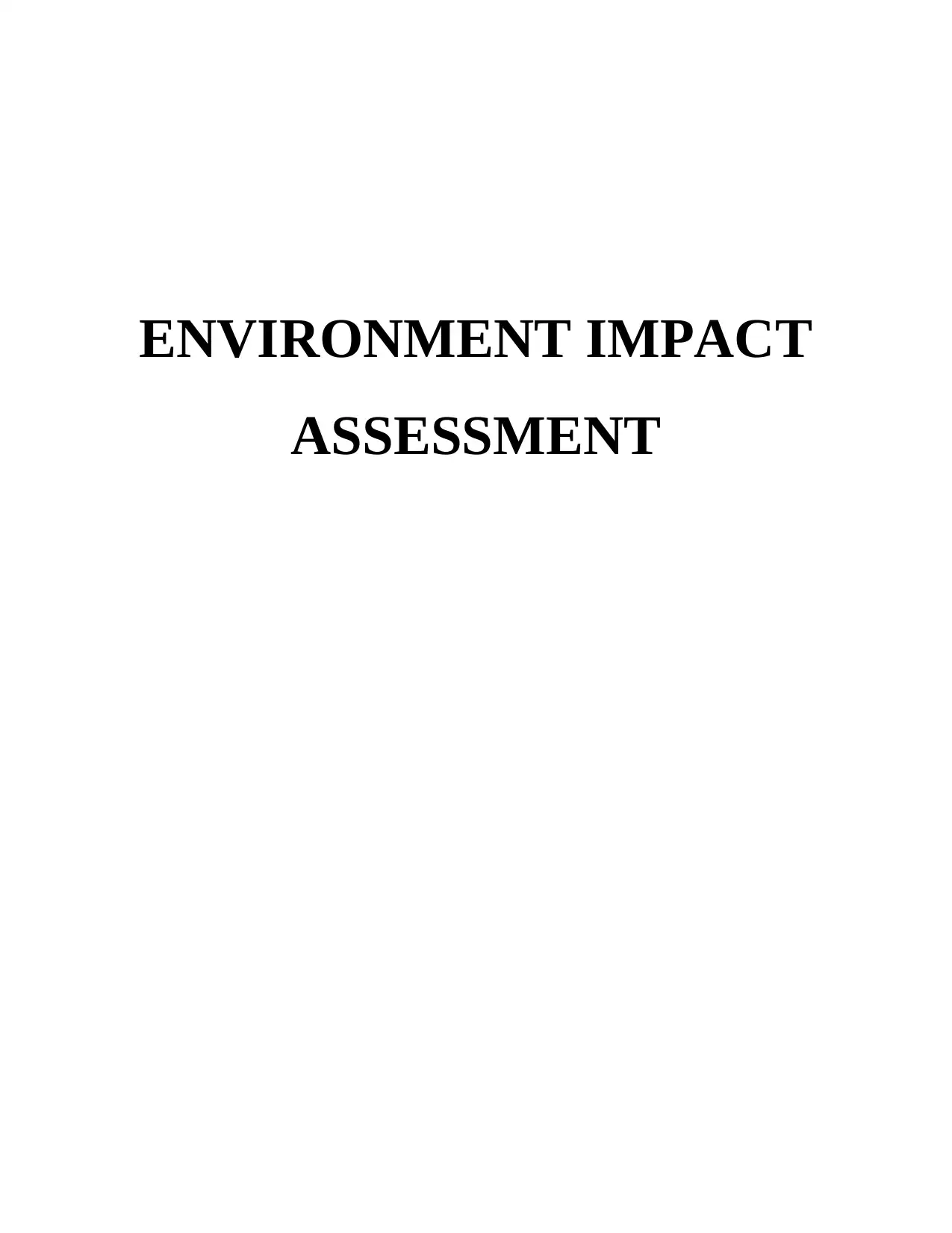
ENVIRONMENT IMPACT
ASSESSMENT
ASSESSMENT
Paraphrase This Document
Need a fresh take? Get an instant paraphrase of this document with our AI Paraphraser

TABLE OF CONTENTS
Introduction, purpose and background............................................................................................1
Methodology....................................................................................................................................2
Assessment of environmental impact statement..............................................................................3
Range and characteristics of environmental impacts including the treatment of indirect and
cumulative impacts......................................................................................................................3
Appropriateness of methods and techniques used to gather, analyse and present environmental
information..................................................................................................................................4
Approaches used to describe ES and identify uncertainties associated with the project:............5
Appropriateness and clarity of criteria used to make judgements about environmental impact
significance and mitigation methods...........................................................................................6
Assessment of treatment of either social or human health impacts.................................................7
Public participation can be undertaken giving regard to timing and effectiveness of proposed
methods............................................................................................................................................8
Conclusion.....................................................................................................................................10
REREFENCES..............................................................................................................................12
Introduction, purpose and background............................................................................................1
Methodology....................................................................................................................................2
Assessment of environmental impact statement..............................................................................3
Range and characteristics of environmental impacts including the treatment of indirect and
cumulative impacts......................................................................................................................3
Appropriateness of methods and techniques used to gather, analyse and present environmental
information..................................................................................................................................4
Approaches used to describe ES and identify uncertainties associated with the project:............5
Appropriateness and clarity of criteria used to make judgements about environmental impact
significance and mitigation methods...........................................................................................6
Assessment of treatment of either social or human health impacts.................................................7
Public participation can be undertaken giving regard to timing and effectiveness of proposed
methods............................................................................................................................................8
Conclusion.....................................................................................................................................10
REREFENCES..............................................................................................................................12

Executive Summary
Purpose: EIS statement helps in describing the effect of an activity upon the environment. In this
report an EIS statement has been created of a project of development of four turbine wind farm
on an agricultural land at a site in order to create valuable assistances to viable improvement of
the project and gain planning consent.
Methodology: Adapted version of the Oxford Brookes review package: 94 criteria, sub-sections
and sections. As a group, section grades were assigned based on subsection grades and key
subsection criteria. Group assigned overall ES grade based on section grades and entire ES key
criteria
Findings: Final ES grade was done on the basis of omission of criteria’s that further resulted in
led to the lowering of the grade.
Conclusion: final grade that was assigned to EIS review of Hemsby wind farm was D. This was
majorly because of various kinds of reasons such as: no public participation took place, genuine
alternatives were considered for this project, Health impacts, accidents and waste generation was
not addressed in fact were ignored and lastly, Mitigation and monitoring measures were not
explicit enough.
Introduction, purpose and background
Environment impact statement can be defined as a document which is prepared in order
to the describe effects of a proposed activity upon the environment (both natural and physical
environment). It further helps in analysing the relationship of people with the environment.
Whereas Environment impact assessment is a process that helps in evaluating likely environment
impact of a development or project taking into account inter-related socio-economic, cultural and
human-health impacts, both beneficial and adverse (Ivanova et. al., 2016). The main purpose of
this report is to assess contribution of project though EIA process considering characteristics of
environmental impact, approaches and procedures used to collect, examine the present
environmental data, value of data and information offered together with management of
uncertainties, mitigation methods to reduce negative impact upon environment.
Aim:
The study is to appraise the efficacy of the EIS in order to create valuable assistance to viable
improvement of the project and gain planning consent.
1
Purpose: EIS statement helps in describing the effect of an activity upon the environment. In this
report an EIS statement has been created of a project of development of four turbine wind farm
on an agricultural land at a site in order to create valuable assistances to viable improvement of
the project and gain planning consent.
Methodology: Adapted version of the Oxford Brookes review package: 94 criteria, sub-sections
and sections. As a group, section grades were assigned based on subsection grades and key
subsection criteria. Group assigned overall ES grade based on section grades and entire ES key
criteria
Findings: Final ES grade was done on the basis of omission of criteria’s that further resulted in
led to the lowering of the grade.
Conclusion: final grade that was assigned to EIS review of Hemsby wind farm was D. This was
majorly because of various kinds of reasons such as: no public participation took place, genuine
alternatives were considered for this project, Health impacts, accidents and waste generation was
not addressed in fact were ignored and lastly, Mitigation and monitoring measures were not
explicit enough.
Introduction, purpose and background
Environment impact statement can be defined as a document which is prepared in order
to the describe effects of a proposed activity upon the environment (both natural and physical
environment). It further helps in analysing the relationship of people with the environment.
Whereas Environment impact assessment is a process that helps in evaluating likely environment
impact of a development or project taking into account inter-related socio-economic, cultural and
human-health impacts, both beneficial and adverse (Ivanova et. al., 2016). The main purpose of
this report is to assess contribution of project though EIA process considering characteristics of
environmental impact, approaches and procedures used to collect, examine the present
environmental data, value of data and information offered together with management of
uncertainties, mitigation methods to reduce negative impact upon environment.
Aim:
The study is to appraise the efficacy of the EIS in order to create valuable assistance to viable
improvement of the project and gain planning consent.
1
⊘ This is a preview!⊘
Do you want full access?
Subscribe today to unlock all pages.

Trusted by 1+ million students worldwide
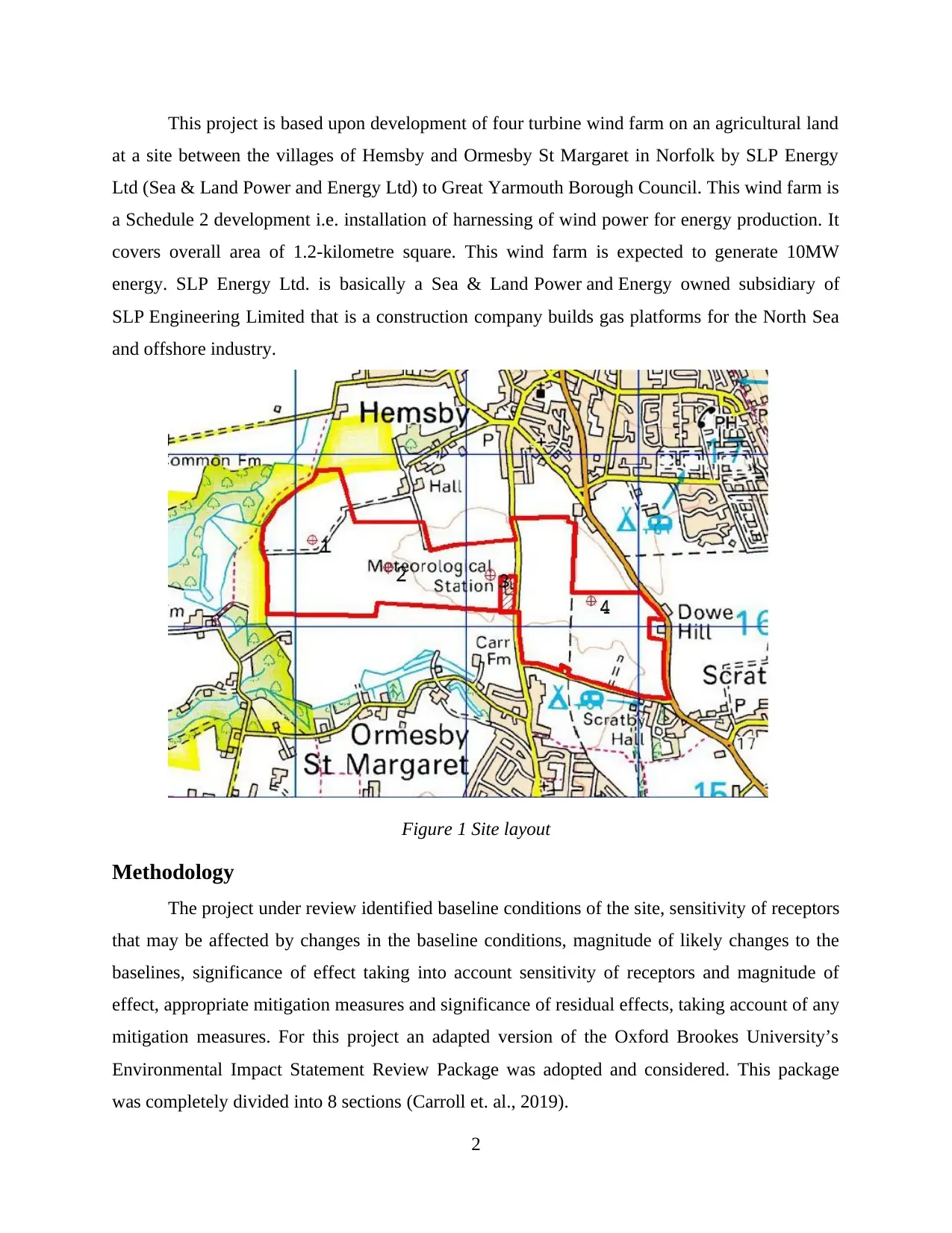
This project is based upon development of four turbine wind farm on an agricultural land
at a site between the villages of Hemsby and Ormesby St Margaret in Norfolk by SLP Energy
Ltd (Sea & Land Power and Energy Ltd) to Great Yarmouth Borough Council. This wind farm is
a Schedule 2 development i.e. installation of harnessing of wind power for energy production. It
covers overall area of 1.2-kilometre square. This wind farm is expected to generate 10MW
energy. SLP Energy Ltd. is basically a Sea & Land Power and Energy owned subsidiary of
SLP Engineering Limited that is a construction company builds gas platforms for the North Sea
and offshore industry.
Figure 1 Site layout
Methodology
The project under review identified baseline conditions of the site, sensitivity of receptors
that may be affected by changes in the baseline conditions, magnitude of likely changes to the
baselines, significance of effect taking into account sensitivity of receptors and magnitude of
effect, appropriate mitigation measures and significance of residual effects, taking account of any
mitigation measures. For this project an adapted version of the Oxford Brookes University’s
Environmental Impact Statement Review Package was adopted and considered. This package
was completely divided into 8 sections (Carroll et. al., 2019).
2
at a site between the villages of Hemsby and Ormesby St Margaret in Norfolk by SLP Energy
Ltd (Sea & Land Power and Energy Ltd) to Great Yarmouth Borough Council. This wind farm is
a Schedule 2 development i.e. installation of harnessing of wind power for energy production. It
covers overall area of 1.2-kilometre square. This wind farm is expected to generate 10MW
energy. SLP Energy Ltd. is basically a Sea & Land Power and Energy owned subsidiary of
SLP Engineering Limited that is a construction company builds gas platforms for the North Sea
and offshore industry.
Figure 1 Site layout
Methodology
The project under review identified baseline conditions of the site, sensitivity of receptors
that may be affected by changes in the baseline conditions, magnitude of likely changes to the
baselines, significance of effect taking into account sensitivity of receptors and magnitude of
effect, appropriate mitigation measures and significance of residual effects, taking account of any
mitigation measures. For this project an adapted version of the Oxford Brookes University’s
Environmental Impact Statement Review Package was adopted and considered. This package
was completely divided into 8 sections (Carroll et. al., 2019).
2
Paraphrase This Document
Need a fresh take? Get an instant paraphrase of this document with our AI Paraphraser
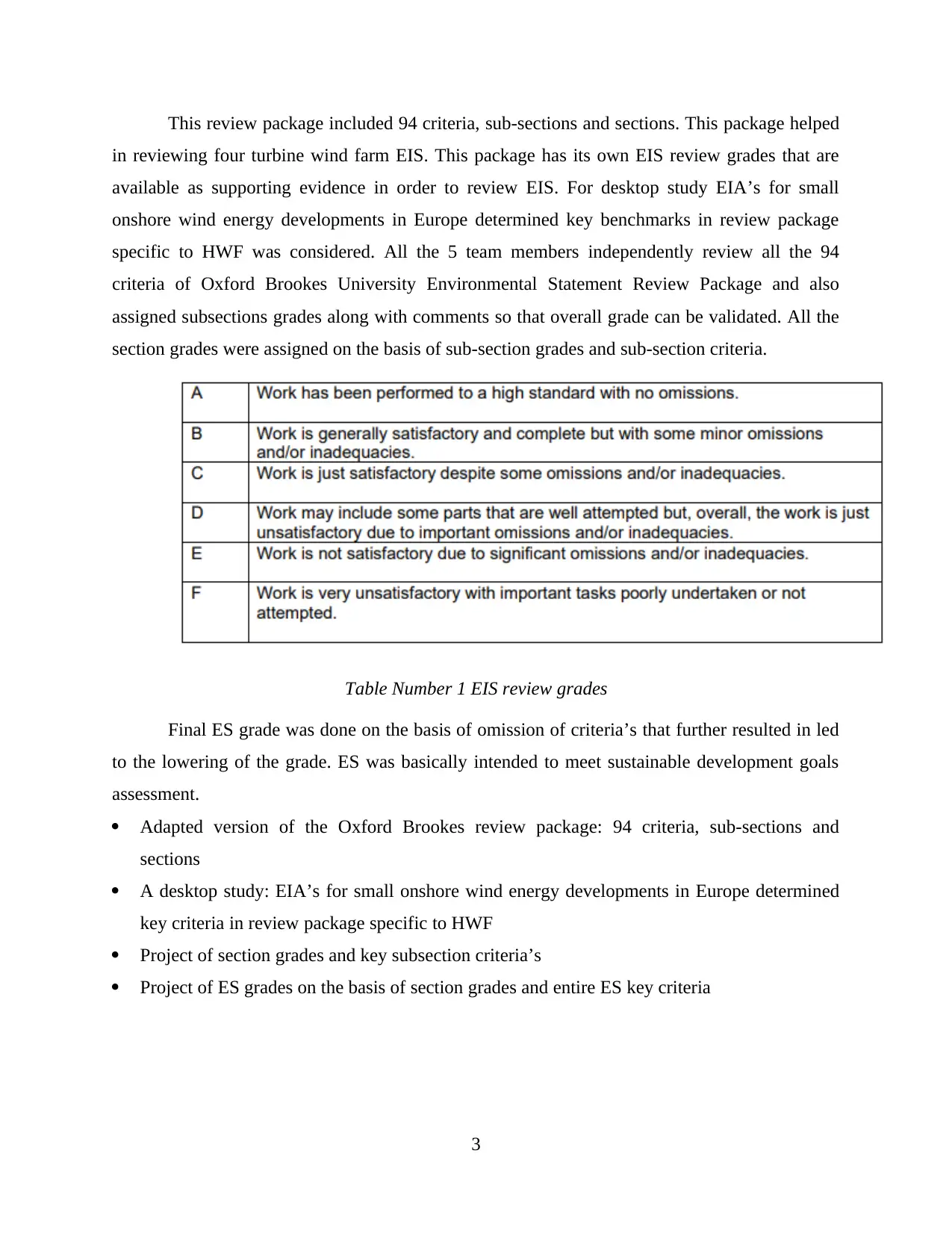
This review package included 94 criteria, sub-sections and sections. This package helped
in reviewing four turbine wind farm EIS. This package has its own EIS review grades that are
available as supporting evidence in order to review EIS. For desktop study EIA’s for small
onshore wind energy developments in Europe determined key benchmarks in review package
specific to HWF was considered. All the 5 team members independently review all the 94
criteria of Oxford Brookes University Environmental Statement Review Package and also
assigned subsections grades along with comments so that overall grade can be validated. All the
section grades were assigned on the basis of sub-section grades and sub-section criteria.
Table Number 1 EIS review grades
Final ES grade was done on the basis of omission of criteria’s that further resulted in led
to the lowering of the grade. ES was basically intended to meet sustainable development goals
assessment.
Adapted version of the Oxford Brookes review package: 94 criteria, sub-sections and
sections
A desktop study: EIA’s for small onshore wind energy developments in Europe determined
key criteria in review package specific to HWF
Project of section grades and key subsection criteria’s
Project of ES grades on the basis of section grades and entire ES key criteria
3
in reviewing four turbine wind farm EIS. This package has its own EIS review grades that are
available as supporting evidence in order to review EIS. For desktop study EIA’s for small
onshore wind energy developments in Europe determined key benchmarks in review package
specific to HWF was considered. All the 5 team members independently review all the 94
criteria of Oxford Brookes University Environmental Statement Review Package and also
assigned subsections grades along with comments so that overall grade can be validated. All the
section grades were assigned on the basis of sub-section grades and sub-section criteria.
Table Number 1 EIS review grades
Final ES grade was done on the basis of omission of criteria’s that further resulted in led
to the lowering of the grade. ES was basically intended to meet sustainable development goals
assessment.
Adapted version of the Oxford Brookes review package: 94 criteria, sub-sections and
sections
A desktop study: EIA’s for small onshore wind energy developments in Europe determined
key criteria in review package specific to HWF
Project of section grades and key subsection criteria’s
Project of ES grades on the basis of section grades and entire ES key criteria
3

Assessment of environmental impact statement
Results overview
According to the results obtained from review packages it was identified that assigned
EIS grade was D as it did not have public participation, Health impacts, accidents and waste
generation were not addressed and mitigation and monitoring measures were not explicit enough.
Table showing results of grade
Criteria Grade Comment
Explains the purpose and objectives of
the development
C There is no clearly written purpose and
objectives, although, it is mentioned within
the body of the EIS
Defines the area taken up by the
development and any associated
ancillary facilities, and shows their
location on a map.
A Clearly defines land requirement
Describes the nature and quantities of
materials needed during the operational
phase including energy demand,
materials and natural resources
A Given with appropriate details
Estimates the type and quantities of
waste matter, energy and residual
materials generated during construction
F Oil and concrete waste stated but no
mention of the quantities
Indicates the area expected to be affected
by the aspects of the project including
maps. Explains the time over which
impacts are likely to occur.
C Adequate onsite details No detailed
explanation of timing
Discusses the methods used to
investigate the affected environment and
justifies their selection ensuring that
these are appropriate to the size and
complexity of the assessment task
D Does not entirely account for uncertainty in
assessment
Describes and justifies scoping methods B Both statutory and nonstatutory consultees
4
Results overview
According to the results obtained from review packages it was identified that assigned
EIS grade was D as it did not have public participation, Health impacts, accidents and waste
generation were not addressed and mitigation and monitoring measures were not explicit enough.
Table showing results of grade
Criteria Grade Comment
Explains the purpose and objectives of
the development
C There is no clearly written purpose and
objectives, although, it is mentioned within
the body of the EIS
Defines the area taken up by the
development and any associated
ancillary facilities, and shows their
location on a map.
A Clearly defines land requirement
Describes the nature and quantities of
materials needed during the operational
phase including energy demand,
materials and natural resources
A Given with appropriate details
Estimates the type and quantities of
waste matter, energy and residual
materials generated during construction
F Oil and concrete waste stated but no
mention of the quantities
Indicates the area expected to be affected
by the aspects of the project including
maps. Explains the time over which
impacts are likely to occur.
C Adequate onsite details No detailed
explanation of timing
Discusses the methods used to
investigate the affected environment and
justifies their selection ensuring that
these are appropriate to the size and
complexity of the assessment task
D Does not entirely account for uncertainty in
assessment
Describes and justifies scoping methods B Both statutory and nonstatutory consultees
4
⊘ This is a preview!⊘
Do you want full access?
Subscribe today to unlock all pages.

Trusted by 1+ million students worldwide
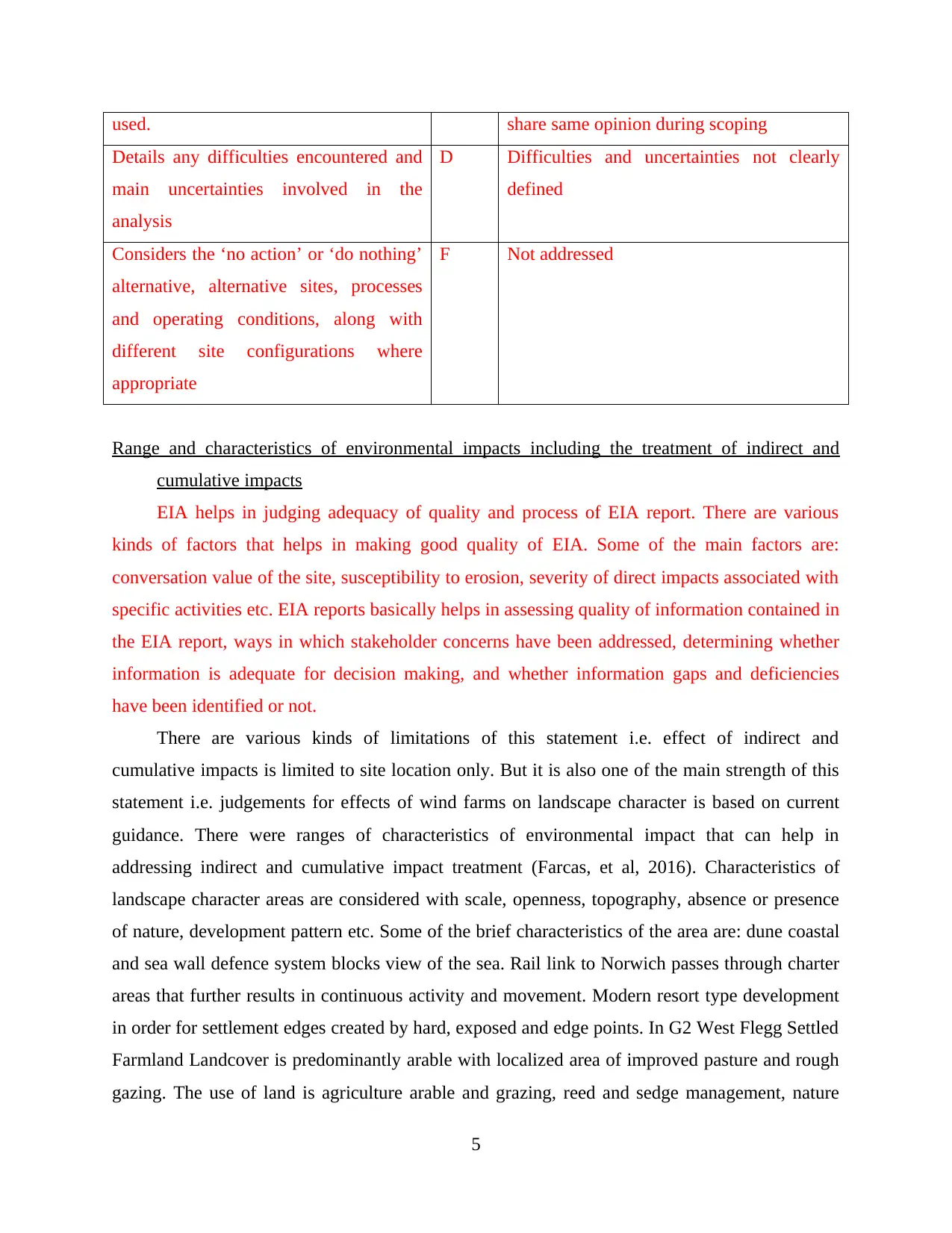
used. share same opinion during scoping
Details any difficulties encountered and
main uncertainties involved in the
analysis
D Difficulties and uncertainties not clearly
defined
Considers the ‘no action’ or ‘do nothing’
alternative, alternative sites, processes
and operating conditions, along with
different site configurations where
appropriate
F Not addressed
Range and characteristics of environmental impacts including the treatment of indirect and
cumulative impacts
EIA helps in judging adequacy of quality and process of EIA report. There are various
kinds of factors that helps in making good quality of EIA. Some of the main factors are:
conversation value of the site, susceptibility to erosion, severity of direct impacts associated with
specific activities etc. EIA reports basically helps in assessing quality of information contained in
the EIA report, ways in which stakeholder concerns have been addressed, determining whether
information is adequate for decision making, and whether information gaps and deficiencies
have been identified or not.
There are various kinds of limitations of this statement i.e. effect of indirect and
cumulative impacts is limited to site location only. But it is also one of the main strength of this
statement i.e. judgements for effects of wind farms on landscape character is based on current
guidance. There were ranges of characteristics of environmental impact that can help in
addressing indirect and cumulative impact treatment (Farcas, et al, 2016). Characteristics of
landscape character areas are considered with scale, openness, topography, absence or presence
of nature, development pattern etc. Some of the brief characteristics of the area are: dune coastal
and sea wall defence system blocks view of the sea. Rail link to Norwich passes through charter
areas that further results in continuous activity and movement. Modern resort type development
in order for settlement edges created by hard, exposed and edge points. In G2 West Flegg Settled
Farmland Landcover is predominantly arable with localized area of improved pasture and rough
gazing. The use of land is agriculture arable and grazing, reed and sedge management, nature
5
Details any difficulties encountered and
main uncertainties involved in the
analysis
D Difficulties and uncertainties not clearly
defined
Considers the ‘no action’ or ‘do nothing’
alternative, alternative sites, processes
and operating conditions, along with
different site configurations where
appropriate
F Not addressed
Range and characteristics of environmental impacts including the treatment of indirect and
cumulative impacts
EIA helps in judging adequacy of quality and process of EIA report. There are various
kinds of factors that helps in making good quality of EIA. Some of the main factors are:
conversation value of the site, susceptibility to erosion, severity of direct impacts associated with
specific activities etc. EIA reports basically helps in assessing quality of information contained in
the EIA report, ways in which stakeholder concerns have been addressed, determining whether
information is adequate for decision making, and whether information gaps and deficiencies
have been identified or not.
There are various kinds of limitations of this statement i.e. effect of indirect and
cumulative impacts is limited to site location only. But it is also one of the main strength of this
statement i.e. judgements for effects of wind farms on landscape character is based on current
guidance. There were ranges of characteristics of environmental impact that can help in
addressing indirect and cumulative impact treatment (Farcas, et al, 2016). Characteristics of
landscape character areas are considered with scale, openness, topography, absence or presence
of nature, development pattern etc. Some of the brief characteristics of the area are: dune coastal
and sea wall defence system blocks view of the sea. Rail link to Norwich passes through charter
areas that further results in continuous activity and movement. Modern resort type development
in order for settlement edges created by hard, exposed and edge points. In G2 West Flegg Settled
Farmland Landcover is predominantly arable with localized area of improved pasture and rough
gazing. The use of land is agriculture arable and grazing, reed and sedge management, nature
5
Paraphrase This Document
Need a fresh take? Get an instant paraphrase of this document with our AI Paraphraser
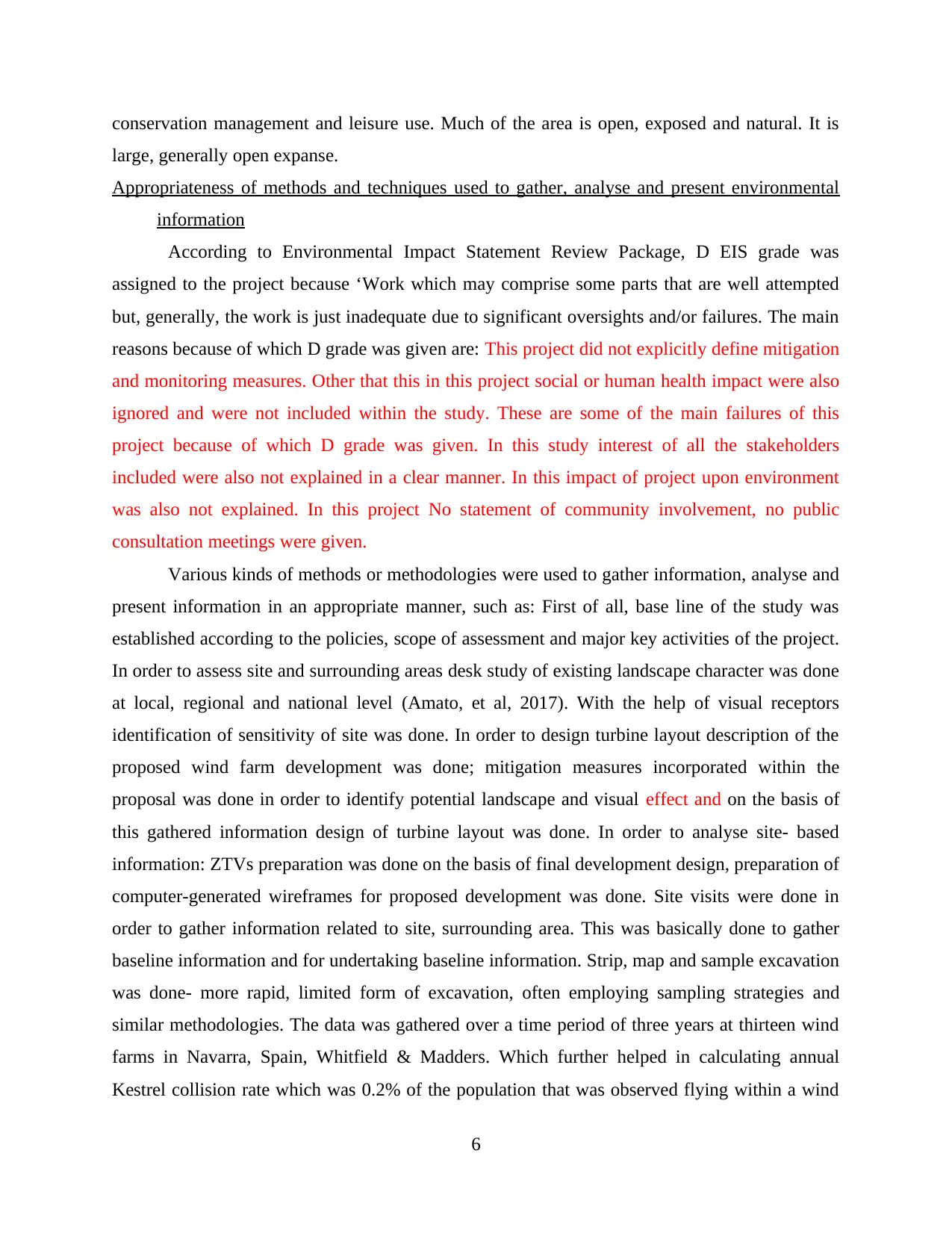
conservation management and leisure use. Much of the area is open, exposed and natural. It is
large, generally open expanse.
Appropriateness of methods and techniques used to gather, analyse and present environmental
information
According to Environmental Impact Statement Review Package, D EIS grade was
assigned to the project because ‘Work which may comprise some parts that are well attempted
but, generally, the work is just inadequate due to significant oversights and/or failures. The main
reasons because of which D grade was given are: This project did not explicitly define mitigation
and monitoring measures. Other that this in this project social or human health impact were also
ignored and were not included within the study. These are some of the main failures of this
project because of which D grade was given. In this study interest of all the stakeholders
included were also not explained in a clear manner. In this impact of project upon environment
was also not explained. In this project No statement of community involvement, no public
consultation meetings were given.
Various kinds of methods or methodologies were used to gather information, analyse and
present information in an appropriate manner, such as: First of all, base line of the study was
established according to the policies, scope of assessment and major key activities of the project.
In order to assess site and surrounding areas desk study of existing landscape character was done
at local, regional and national level (Amato, et al, 2017). With the help of visual receptors
identification of sensitivity of site was done. In order to design turbine layout description of the
proposed wind farm development was done; mitigation measures incorporated within the
proposal was done in order to identify potential landscape and visual effect and on the basis of
this gathered information design of turbine layout was done. In order to analyse site- based
information: ZTVs preparation was done on the basis of final development design, preparation of
computer-generated wireframes for proposed development was done. Site visits were done in
order to gather information related to site, surrounding area. This was basically done to gather
baseline information and for undertaking baseline information. Strip, map and sample excavation
was done- more rapid, limited form of excavation, often employing sampling strategies and
similar methodologies. The data was gathered over a time period of three years at thirteen wind
farms in Navarra, Spain, Whitfield & Madders. Which further helped in calculating annual
Kestrel collision rate which was 0.2% of the population that was observed flying within a wind
6
large, generally open expanse.
Appropriateness of methods and techniques used to gather, analyse and present environmental
information
According to Environmental Impact Statement Review Package, D EIS grade was
assigned to the project because ‘Work which may comprise some parts that are well attempted
but, generally, the work is just inadequate due to significant oversights and/or failures. The main
reasons because of which D grade was given are: This project did not explicitly define mitigation
and monitoring measures. Other that this in this project social or human health impact were also
ignored and were not included within the study. These are some of the main failures of this
project because of which D grade was given. In this study interest of all the stakeholders
included were also not explained in a clear manner. In this impact of project upon environment
was also not explained. In this project No statement of community involvement, no public
consultation meetings were given.
Various kinds of methods or methodologies were used to gather information, analyse and
present information in an appropriate manner, such as: First of all, base line of the study was
established according to the policies, scope of assessment and major key activities of the project.
In order to assess site and surrounding areas desk study of existing landscape character was done
at local, regional and national level (Amato, et al, 2017). With the help of visual receptors
identification of sensitivity of site was done. In order to design turbine layout description of the
proposed wind farm development was done; mitigation measures incorporated within the
proposal was done in order to identify potential landscape and visual effect and on the basis of
this gathered information design of turbine layout was done. In order to analyse site- based
information: ZTVs preparation was done on the basis of final development design, preparation of
computer-generated wireframes for proposed development was done. Site visits were done in
order to gather information related to site, surrounding area. This was basically done to gather
baseline information and for undertaking baseline information. Strip, map and sample excavation
was done- more rapid, limited form of excavation, often employing sampling strategies and
similar methodologies. The data was gathered over a time period of three years at thirteen wind
farms in Navarra, Spain, Whitfield & Madders. Which further helped in calculating annual
Kestrel collision rate which was 0.2% of the population that was observed flying within a wind
6
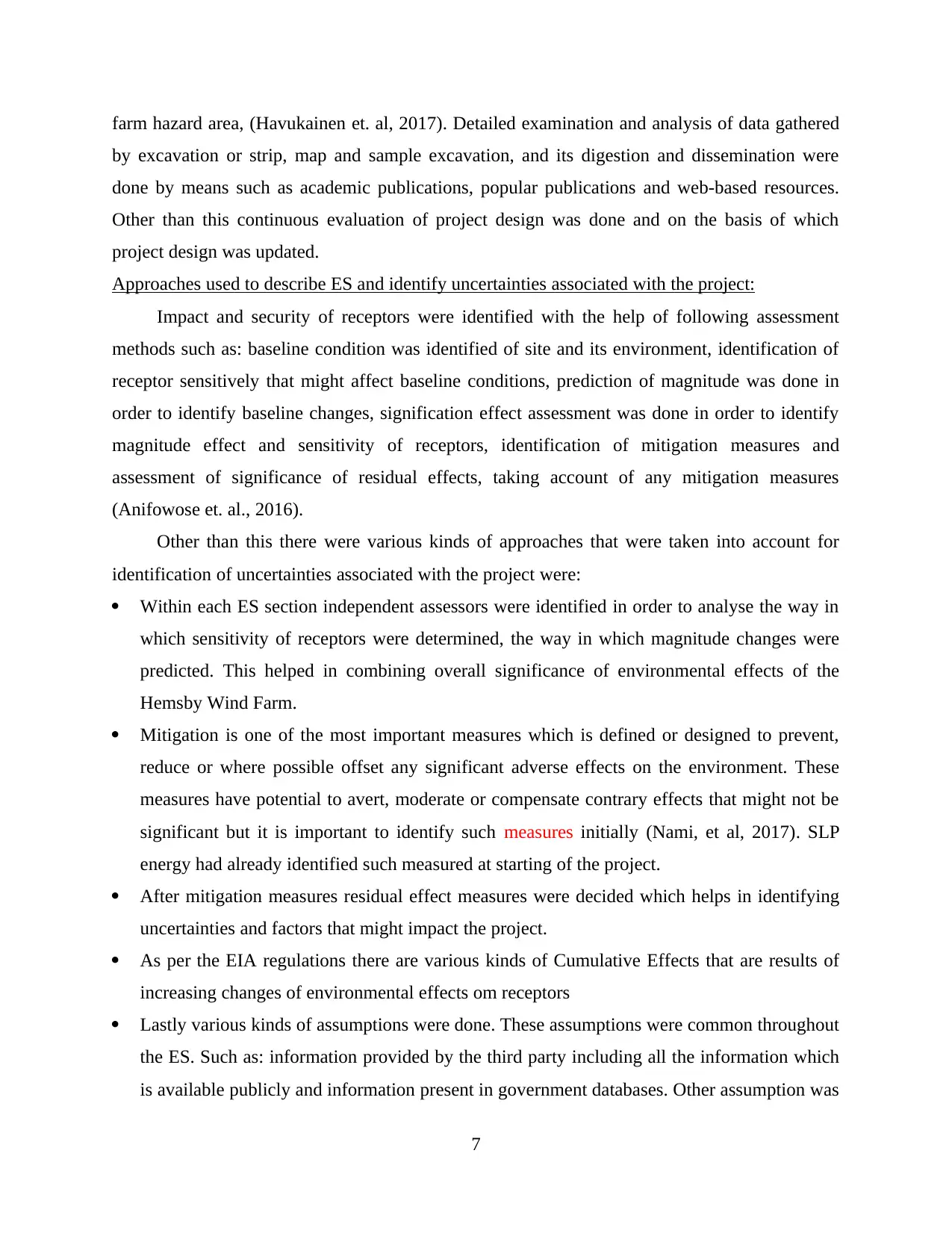
farm hazard area, (Havukainen et. al, 2017). Detailed examination and analysis of data gathered
by excavation or strip, map and sample excavation, and its digestion and dissemination were
done by means such as academic publications, popular publications and web-based resources.
Other than this continuous evaluation of project design was done and on the basis of which
project design was updated.
Approaches used to describe ES and identify uncertainties associated with the project:
Impact and security of receptors were identified with the help of following assessment
methods such as: baseline condition was identified of site and its environment, identification of
receptor sensitively that might affect baseline conditions, prediction of magnitude was done in
order to identify baseline changes, signification effect assessment was done in order to identify
magnitude effect and sensitivity of receptors, identification of mitigation measures and
assessment of significance of residual effects, taking account of any mitigation measures
(Anifowose et. al., 2016).
Other than this there were various kinds of approaches that were taken into account for
identification of uncertainties associated with the project were:
Within each ES section independent assessors were identified in order to analyse the way in
which sensitivity of receptors were determined, the way in which magnitude changes were
predicted. This helped in combining overall significance of environmental effects of the
Hemsby Wind Farm.
Mitigation is one of the most important measures which is defined or designed to prevent,
reduce or where possible offset any significant adverse effects on the environment. These
measures have potential to avert, moderate or compensate contrary effects that might not be
significant but it is important to identify such measures initially (Nami, et al, 2017). SLP
energy had already identified such measured at starting of the project.
After mitigation measures residual effect measures were decided which helps in identifying
uncertainties and factors that might impact the project.
As per the EIA regulations there are various kinds of Cumulative Effects that are results of
increasing changes of environmental effects om receptors
Lastly various kinds of assumptions were done. These assumptions were common throughout
the ES. Such as: information provided by the third party including all the information which
is available publicly and information present in government databases. Other assumption was
7
by excavation or strip, map and sample excavation, and its digestion and dissemination were
done by means such as academic publications, popular publications and web-based resources.
Other than this continuous evaluation of project design was done and on the basis of which
project design was updated.
Approaches used to describe ES and identify uncertainties associated with the project:
Impact and security of receptors were identified with the help of following assessment
methods such as: baseline condition was identified of site and its environment, identification of
receptor sensitively that might affect baseline conditions, prediction of magnitude was done in
order to identify baseline changes, signification effect assessment was done in order to identify
magnitude effect and sensitivity of receptors, identification of mitigation measures and
assessment of significance of residual effects, taking account of any mitigation measures
(Anifowose et. al., 2016).
Other than this there were various kinds of approaches that were taken into account for
identification of uncertainties associated with the project were:
Within each ES section independent assessors were identified in order to analyse the way in
which sensitivity of receptors were determined, the way in which magnitude changes were
predicted. This helped in combining overall significance of environmental effects of the
Hemsby Wind Farm.
Mitigation is one of the most important measures which is defined or designed to prevent,
reduce or where possible offset any significant adverse effects on the environment. These
measures have potential to avert, moderate or compensate contrary effects that might not be
significant but it is important to identify such measures initially (Nami, et al, 2017). SLP
energy had already identified such measured at starting of the project.
After mitigation measures residual effect measures were decided which helps in identifying
uncertainties and factors that might impact the project.
As per the EIA regulations there are various kinds of Cumulative Effects that are results of
increasing changes of environmental effects om receptors
Lastly various kinds of assumptions were done. These assumptions were common throughout
the ES. Such as: information provided by the third party including all the information which
is available publicly and information present in government databases. Other assumption was
7
⊘ This is a preview!⊘
Do you want full access?
Subscribe today to unlock all pages.

Trusted by 1+ million students worldwide
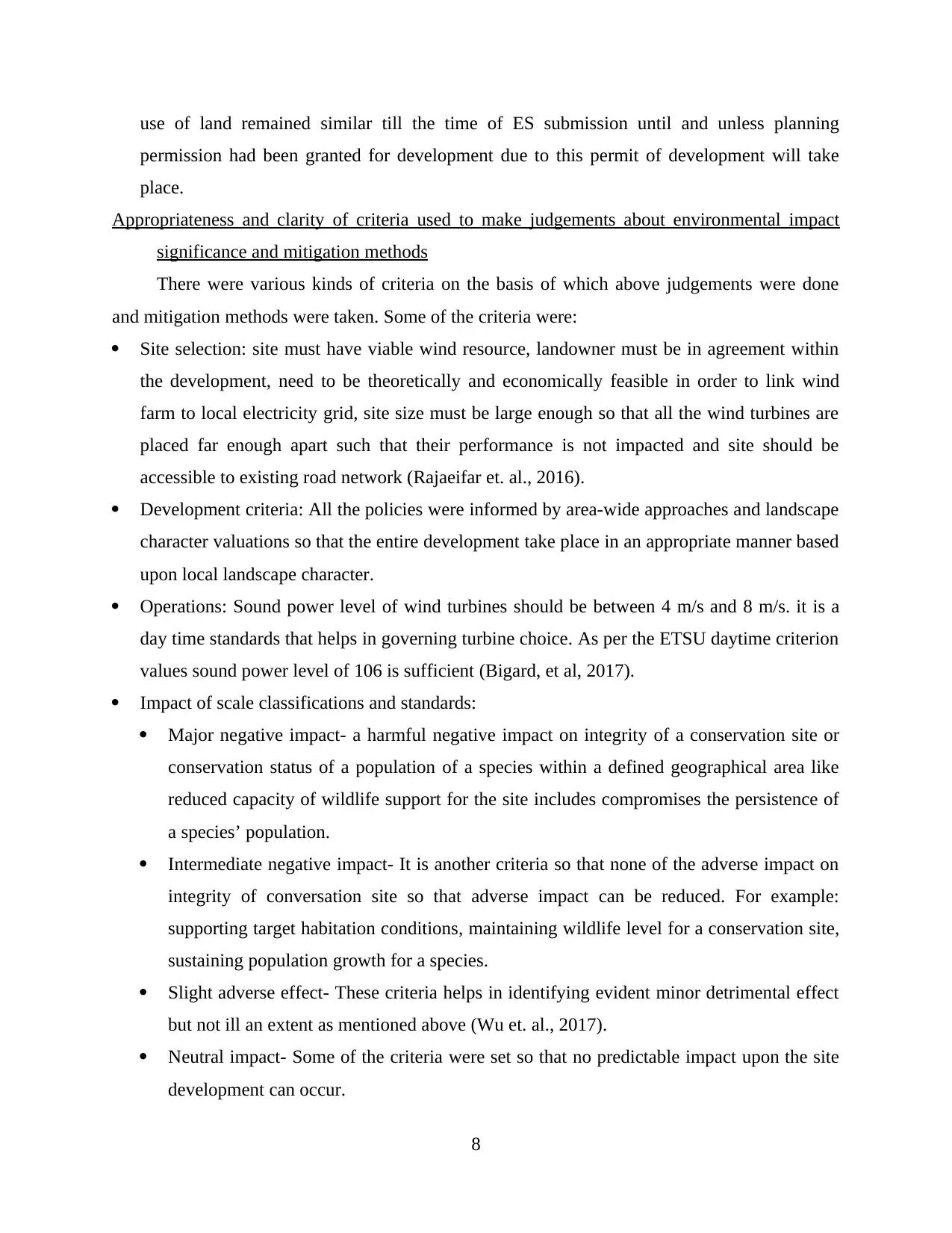
use of land remained similar till the time of ES submission until and unless planning
permission had been granted for development due to this permit of development will take
place.
Appropriateness and clarity of criteria used to make judgements about environmental impact
significance and mitigation methods
There were various kinds of criteria on the basis of which above judgements were done
and mitigation methods were taken. Some of the criteria were:
Site selection: site must have viable wind resource, landowner must be in agreement within
the development, need to be theoretically and economically feasible in order to link wind
farm to local electricity grid, site size must be large enough so that all the wind turbines are
placed far enough apart such that their performance is not impacted and site should be
accessible to existing road network (Rajaeifar et. al., 2016).
Development criteria: All the policies were informed by area-wide approaches and landscape
character valuations so that the entire development take place in an appropriate manner based
upon local landscape character.
Operations: Sound power level of wind turbines should be between 4 m/s and 8 m/s. it is a
day time standards that helps in governing turbine choice. As per the ETSU daytime criterion
values sound power level of 106 is sufficient (Bigard, et al, 2017).
Impact of scale classifications and standards:
Major negative impact- a harmful negative impact on integrity of a conservation site or
conservation status of a population of a species within a defined geographical area like
reduced capacity of wildlife support for the site includes compromises the persistence of
a species’ population.
Intermediate negative impact- It is another criteria so that none of the adverse impact on
integrity of conversation site so that adverse impact can be reduced. For example:
supporting target habitation conditions, maintaining wildlife level for a conservation site,
sustaining population growth for a species.
Slight adverse effect- These criteria helps in identifying evident minor detrimental effect
but not ill an extent as mentioned above (Wu et. al., 2017).
Neutral impact- Some of the criteria were set so that no predictable impact upon the site
development can occur.
8
permission had been granted for development due to this permit of development will take
place.
Appropriateness and clarity of criteria used to make judgements about environmental impact
significance and mitigation methods
There were various kinds of criteria on the basis of which above judgements were done
and mitigation methods were taken. Some of the criteria were:
Site selection: site must have viable wind resource, landowner must be in agreement within
the development, need to be theoretically and economically feasible in order to link wind
farm to local electricity grid, site size must be large enough so that all the wind turbines are
placed far enough apart such that their performance is not impacted and site should be
accessible to existing road network (Rajaeifar et. al., 2016).
Development criteria: All the policies were informed by area-wide approaches and landscape
character valuations so that the entire development take place in an appropriate manner based
upon local landscape character.
Operations: Sound power level of wind turbines should be between 4 m/s and 8 m/s. it is a
day time standards that helps in governing turbine choice. As per the ETSU daytime criterion
values sound power level of 106 is sufficient (Bigard, et al, 2017).
Impact of scale classifications and standards:
Major negative impact- a harmful negative impact on integrity of a conservation site or
conservation status of a population of a species within a defined geographical area like
reduced capacity of wildlife support for the site includes compromises the persistence of
a species’ population.
Intermediate negative impact- It is another criteria so that none of the adverse impact on
integrity of conversation site so that adverse impact can be reduced. For example:
supporting target habitation conditions, maintaining wildlife level for a conservation site,
sustaining population growth for a species.
Slight adverse effect- These criteria helps in identifying evident minor detrimental effect
but not ill an extent as mentioned above (Wu et. al., 2017).
Neutral impact- Some of the criteria were set so that no predictable impact upon the site
development can occur.
8
Paraphrase This Document
Need a fresh take? Get an instant paraphrase of this document with our AI Paraphraser
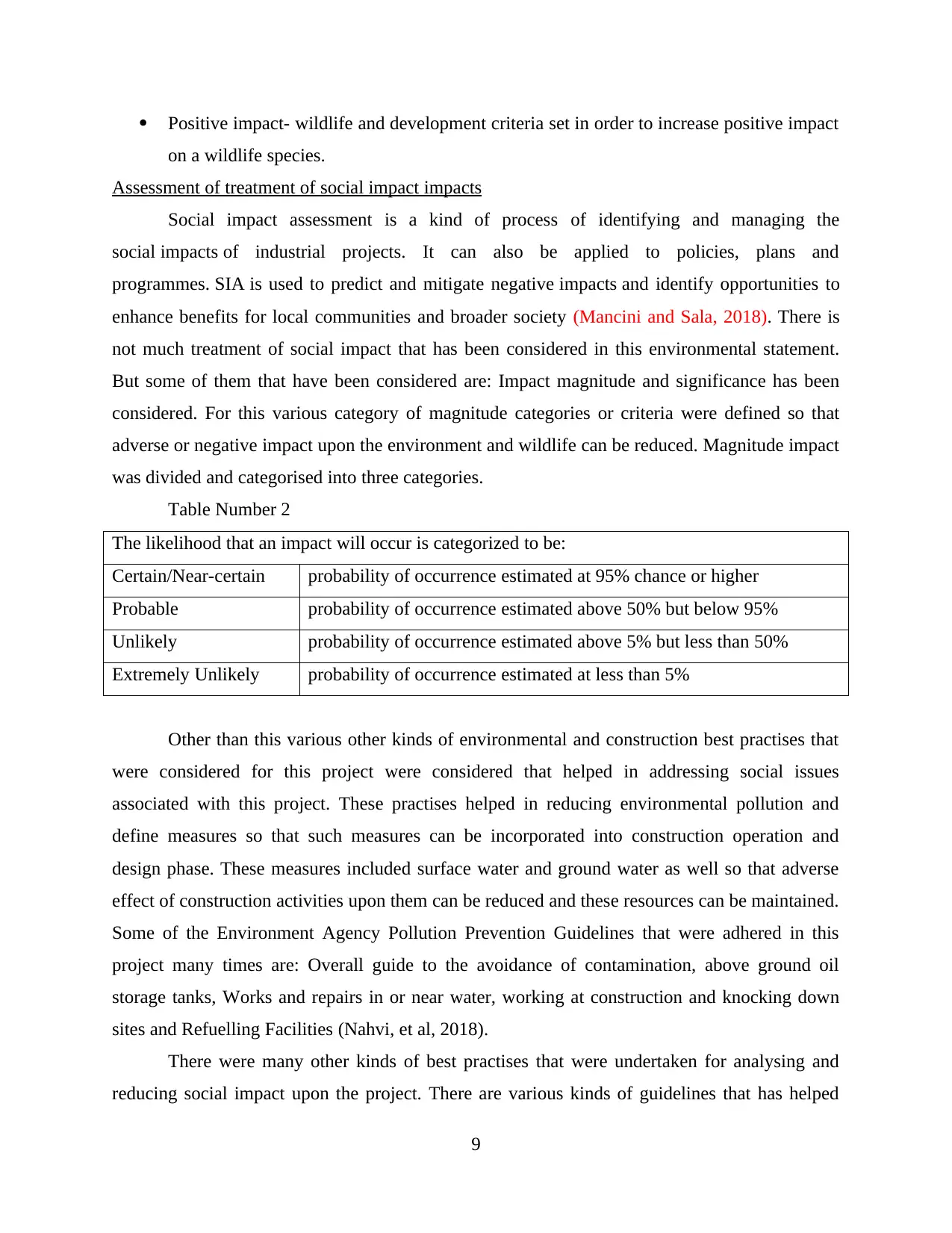
Positive impact- wildlife and development criteria set in order to increase positive impact
on a wildlife species.
Assessment of treatment of social impact impacts
Social impact assessment is a kind of process of identifying and managing the
social impacts of industrial projects. It can also be applied to policies, plans and
programmes. SIA is used to predict and mitigate negative impacts and identify opportunities to
enhance benefits for local communities and broader society (Mancini and Sala, 2018). There is
not much treatment of social impact that has been considered in this environmental statement.
But some of them that have been considered are: Impact magnitude and significance has been
considered. For this various category of magnitude categories or criteria were defined so that
adverse or negative impact upon the environment and wildlife can be reduced. Magnitude impact
was divided and categorised into three categories.
Table Number 2
The likelihood that an impact will occur is categorized to be:
Certain/Near-certain probability of occurrence estimated at 95% chance or higher
Probable probability of occurrence estimated above 50% but below 95%
Unlikely probability of occurrence estimated above 5% but less than 50%
Extremely Unlikely probability of occurrence estimated at less than 5%
Other than this various other kinds of environmental and construction best practises that
were considered for this project were considered that helped in addressing social issues
associated with this project. These practises helped in reducing environmental pollution and
define measures so that such measures can be incorporated into construction operation and
design phase. These measures included surface water and ground water as well so that adverse
effect of construction activities upon them can be reduced and these resources can be maintained.
Some of the Environment Agency Pollution Prevention Guidelines that were adhered in this
project many times are: Overall guide to the avoidance of contamination, above ground oil
storage tanks, Works and repairs in or near water, working at construction and knocking down
sites and Refuelling Facilities (Nahvi, et al, 2018).
There were many other kinds of best practises that were undertaken for analysing and
reducing social impact upon the project. There are various kinds of guidelines that has helped
9
on a wildlife species.
Assessment of treatment of social impact impacts
Social impact assessment is a kind of process of identifying and managing the
social impacts of industrial projects. It can also be applied to policies, plans and
programmes. SIA is used to predict and mitigate negative impacts and identify opportunities to
enhance benefits for local communities and broader society (Mancini and Sala, 2018). There is
not much treatment of social impact that has been considered in this environmental statement.
But some of them that have been considered are: Impact magnitude and significance has been
considered. For this various category of magnitude categories or criteria were defined so that
adverse or negative impact upon the environment and wildlife can be reduced. Magnitude impact
was divided and categorised into three categories.
Table Number 2
The likelihood that an impact will occur is categorized to be:
Certain/Near-certain probability of occurrence estimated at 95% chance or higher
Probable probability of occurrence estimated above 50% but below 95%
Unlikely probability of occurrence estimated above 5% but less than 50%
Extremely Unlikely probability of occurrence estimated at less than 5%
Other than this various other kinds of environmental and construction best practises that
were considered for this project were considered that helped in addressing social issues
associated with this project. These practises helped in reducing environmental pollution and
define measures so that such measures can be incorporated into construction operation and
design phase. These measures included surface water and ground water as well so that adverse
effect of construction activities upon them can be reduced and these resources can be maintained.
Some of the Environment Agency Pollution Prevention Guidelines that were adhered in this
project many times are: Overall guide to the avoidance of contamination, above ground oil
storage tanks, Works and repairs in or near water, working at construction and knocking down
sites and Refuelling Facilities (Nahvi, et al, 2018).
There were many other kinds of best practises that were undertaken for analysing and
reducing social impact upon the project. There are various kinds of guidelines that has helped
9
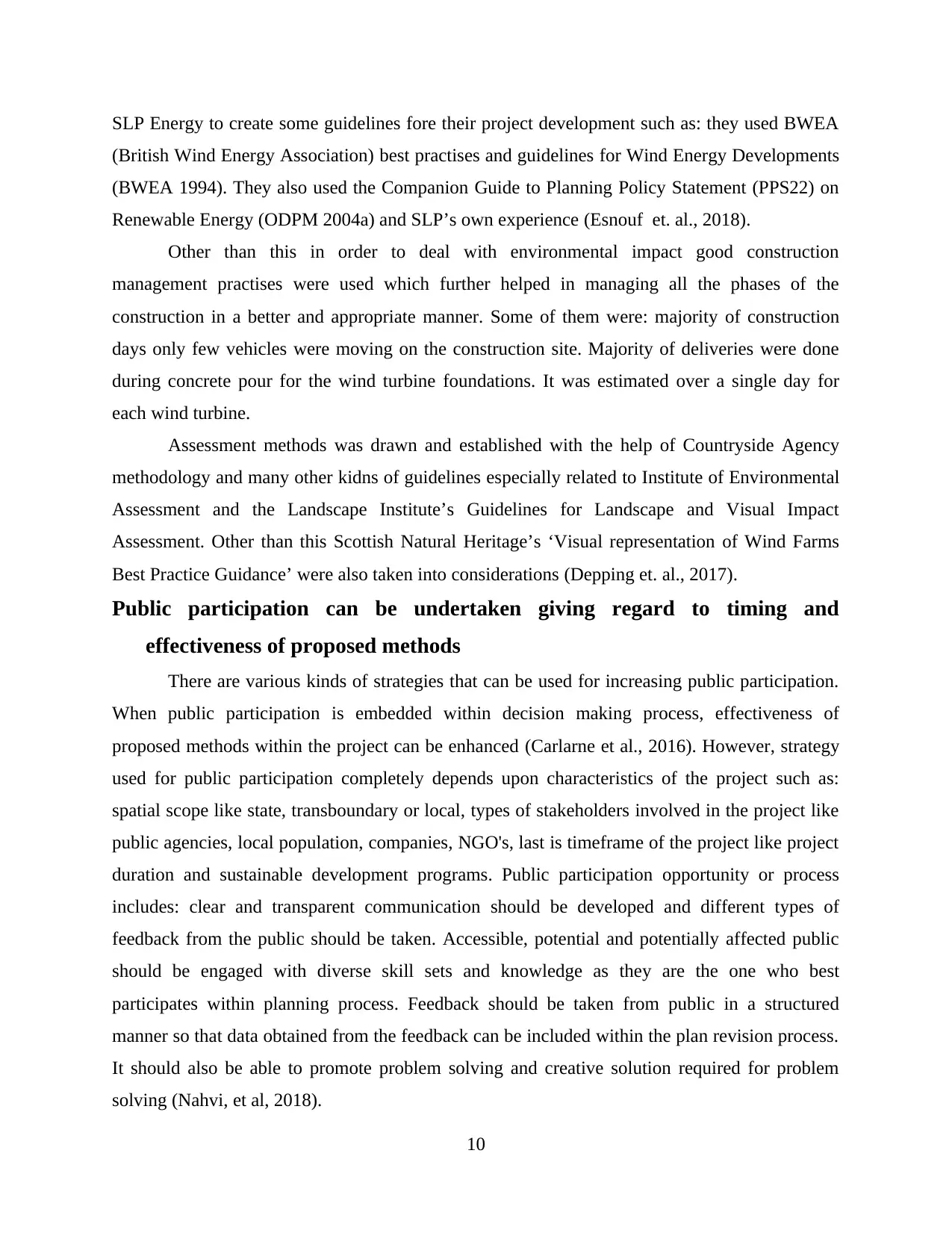
SLP Energy to create some guidelines fore their project development such as: they used BWEA
(British Wind Energy Association) best practises and guidelines for Wind Energy Developments
(BWEA 1994). They also used the Companion Guide to Planning Policy Statement (PPS22) on
Renewable Energy (ODPM 2004a) and SLP’s own experience (Esnouf et. al., 2018).
Other than this in order to deal with environmental impact good construction
management practises were used which further helped in managing all the phases of the
construction in a better and appropriate manner. Some of them were: majority of construction
days only few vehicles were moving on the construction site. Majority of deliveries were done
during concrete pour for the wind turbine foundations. It was estimated over a single day for
each wind turbine.
Assessment methods was drawn and established with the help of Countryside Agency
methodology and many other kidns of guidelines especially related to Institute of Environmental
Assessment and the Landscape Institute’s Guidelines for Landscape and Visual Impact
Assessment. Other than this Scottish Natural Heritage’s ‘Visual representation of Wind Farms
Best Practice Guidance’ were also taken into considerations (Depping et. al., 2017).
Public participation can be undertaken giving regard to timing and
effectiveness of proposed methods
There are various kinds of strategies that can be used for increasing public participation.
When public participation is embedded within decision making process, effectiveness of
proposed methods within the project can be enhanced (Carlarne et al., 2016). However, strategy
used for public participation completely depends upon characteristics of the project such as:
spatial scope like state, transboundary or local, types of stakeholders involved in the project like
public agencies, local population, companies, NGO's, last is timeframe of the project like project
duration and sustainable development programs. Public participation opportunity or process
includes: clear and transparent communication should be developed and different types of
feedback from the public should be taken. Accessible, potential and potentially affected public
should be engaged with diverse skill sets and knowledge as they are the one who best
participates within planning process. Feedback should be taken from public in a structured
manner so that data obtained from the feedback can be included within the plan revision process.
It should also be able to promote problem solving and creative solution required for problem
solving (Nahvi, et al, 2018).
10
(British Wind Energy Association) best practises and guidelines for Wind Energy Developments
(BWEA 1994). They also used the Companion Guide to Planning Policy Statement (PPS22) on
Renewable Energy (ODPM 2004a) and SLP’s own experience (Esnouf et. al., 2018).
Other than this in order to deal with environmental impact good construction
management practises were used which further helped in managing all the phases of the
construction in a better and appropriate manner. Some of them were: majority of construction
days only few vehicles were moving on the construction site. Majority of deliveries were done
during concrete pour for the wind turbine foundations. It was estimated over a single day for
each wind turbine.
Assessment methods was drawn and established with the help of Countryside Agency
methodology and many other kidns of guidelines especially related to Institute of Environmental
Assessment and the Landscape Institute’s Guidelines for Landscape and Visual Impact
Assessment. Other than this Scottish Natural Heritage’s ‘Visual representation of Wind Farms
Best Practice Guidance’ were also taken into considerations (Depping et. al., 2017).
Public participation can be undertaken giving regard to timing and
effectiveness of proposed methods
There are various kinds of strategies that can be used for increasing public participation.
When public participation is embedded within decision making process, effectiveness of
proposed methods within the project can be enhanced (Carlarne et al., 2016). However, strategy
used for public participation completely depends upon characteristics of the project such as:
spatial scope like state, transboundary or local, types of stakeholders involved in the project like
public agencies, local population, companies, NGO's, last is timeframe of the project like project
duration and sustainable development programs. Public participation opportunity or process
includes: clear and transparent communication should be developed and different types of
feedback from the public should be taken. Accessible, potential and potentially affected public
should be engaged with diverse skill sets and knowledge as they are the one who best
participates within planning process. Feedback should be taken from public in a structured
manner so that data obtained from the feedback can be included within the plan revision process.
It should also be able to promote problem solving and creative solution required for problem
solving (Nahvi, et al, 2018).
10
⊘ This is a preview!⊘
Do you want full access?
Subscribe today to unlock all pages.

Trusted by 1+ million students worldwide
1 out of 16
Your All-in-One AI-Powered Toolkit for Academic Success.
+13062052269
info@desklib.com
Available 24*7 on WhatsApp / Email
![[object Object]](/_next/static/media/star-bottom.7253800d.svg)
Unlock your academic potential
Copyright © 2020–2025 A2Z Services. All Rights Reserved. Developed and managed by ZUCOL.
